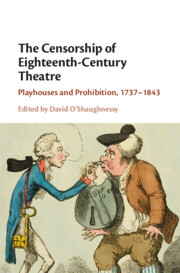Book contents
- The Censorship of Eighteenth-Century Theatre
- The Censorship of Eighteenth-Century Theatre
- Copyright page
- Dedication
- Contents
- Figures
- Contributors
- Acknowledgements
- Abbreviations
- Introduction
- Part I Gender
- Part II Politics
- Part III Performance
- Chapter 7 The Censorship of Personal Satire on the Eighteenth-Century Stage
- Chapter 8 Censoring the Unseen
- Chapter 9 Evading Censorship through Comedy, Improvisation, and Non-verbal Performance in the Early Nineteenth Century
- Chapter 10 Censoring Regency Flash
- Bibliography
- Index
Chapter 9 - Evading Censorship through Comedy, Improvisation, and Non-verbal Performance in the Early Nineteenth Century
from Part III - Performance
Published online by Cambridge University Press: 03 August 2023
- The Censorship of Eighteenth-Century Theatre
- The Censorship of Eighteenth-Century Theatre
- Copyright page
- Dedication
- Contents
- Figures
- Contributors
- Acknowledgements
- Abbreviations
- Introduction
- Part I Gender
- Part II Politics
- Part III Performance
- Chapter 7 The Censorship of Personal Satire on the Eighteenth-Century Stage
- Chapter 8 Censoring the Unseen
- Chapter 9 Evading Censorship through Comedy, Improvisation, and Non-verbal Performance in the Early Nineteenth Century
- Chapter 10 Censoring Regency Flash
- Bibliography
- Index
Summary
Despite strict censorship laws, social and political critiques sometimes occurred in late-eighteenth and early-nineteenth century British theatre through comic and visual elements in melodrama, pantomime, farce and comedy. Drawing on texts and performances c.1790-1830, this chapter focusses on the evasion of censorship, particularly through non-verbal performance. While the pantomime or Harlequinade is the most obvious source for non-verbal critique, there are many other visually subversive moments in the drama of this period, including instances in John Bull (1803) Speed the Plough (1800) and Killing No murder (1809), which will be specifically addressed. The visual power of theatre to undermine censorship will be examined in conjunction with the satirical impact of contemporary prints and caricatures. While an emphasis on action and visual communication in theatre is partly attributable to the increasing size of theatres and growing demand for theatrical entertainment, less attention has been paid to the significance of this development for greater license in what can be communicated to spectators. While the theatrical politics of this period are somewhat more complicated than those of the print shop windows, the markets for theatrical spectacle and satirical prints must have overlapped, creating reciprocal modes of perception in this period.0
- Type
- Chapter
- Information
- The Censorship of Eighteenth-Century TheatrePlayhouses and Prohibition, 1737–1843, pp. 194 - 218Publisher: Cambridge University PressPrint publication year: 2023



